Last Updated on June 12, 2025 by Adam Henige
In today’s digital-first world, having a strong online presence isn’t just nice to have for architectural firms—it’s essential. As potential clients increasingly turn to search engines to find architectural services, your firm’s visibility in search results can make or break your business growth. Welcome to our comprehensive guide on SEO for architects where we’ll walk you through everything you need to know to outrank competitors and attract more qualified leads.
What Does SEO for Architects Even Mean?
This probably seems too obvious of a question, but it’s important to truly understand that search engine optimization has to align user intent with the services an architect provides. What do I mean by that? Let’s first look at how people search for architect-related terminology.
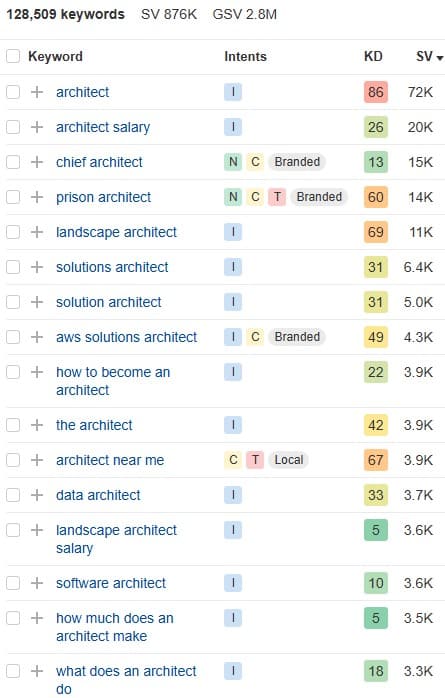
Using one of our keyword research tools, Ahrefs, you can see that they estimate there are over 128,000 keywords related to the seed term “architect.”
Clearly, you can’t optimize for all of these terms, and as an architect or architecture firm, you’ll quickly realize many of these terms don’t even apply to you or your business. For example, even though 3,900 people search for it each month, a top ranking for “how to become an architect” is unlikely to land you a new client.
Before You Start: Know Your Customer, Your Services, and Your Goals
Before we get into the specifics of how to do SEO for your architecture website, you first need to clearly define who your clients are, what specific services you aim to promote, and what success looks like for your project.
Define Your Services
Again, this might seem terribly obvious, but it’s an important step. What specific architecture services do you provide?
- Residential
- Commercial
- Industrial
- Landscape
- Interior
- Urban
- Environmental
- Healthcare
- Educational
- Retail
Once you’ve zeroed in on the services you’ll need to promote, you can then look at your business through the eyes of your potential clients.
Your Targets
Your website, and the keywords you try to rank for, should align perfectly with your clients’ needs. So, if you’re a residential architect, you’ll want to think about your ideal customer and what they look like, and how they would search for your offerings. This should take into account:
- Design specialties. Does your firm have specific designs that you’re known for like ranch-style homes, cottages, etc.
- Geography. Where are your clients and what areas can you service them?
- Informational needs. What do clients typically need to learn about before deciding to use you or your firm? Do they need design examples? Pricing information?
Your Goals
To be successful with architecture SEO you need to first define success. To do so, you’ll need some hard and fast goals to measure your progress. This might take some upfront work, but knowing how many phone calls or emails your website generates right now will give you a baseline for you to set a realistic goal for SEO success. Getting one or two leads per month? Set an initial goal of five to ten and if you hit that mark, you can adjust further.
With those items defined, let’s get into the weeds a bit and start to understand how SEO for architects works.
1. Understanding SEO Fundamentals for Architects
Search Engine Optimization is the process of improving your website to increase its visibility when people search for architectural services on Google and other search engines. For architectural firms, effective SEO means the difference between being discovered by potential clients or remaining hidden behind competitors.
SEO for architects consists of several key components:
- Keyword Research: Researching and identifying keywords that are actively being searched and align customer intent with your services
- On-page SEO: Optimizing individual pages of your website, including content, images, and HTML elements
- Off-page SEO: Building your site’s authority through backlinks and mentions across the web
- Technical SEO: Ensuring your website’s infrastructure allows search engines to crawl and index it properly
- Local SEO: Optimizing your online presence to attract more business from relevant local searches
Search engines rank architectural websites based on hundreds of factors, but the most important include relevance to search queries, website authority, user experience metrics, and content quality. By understanding these fundamentals, you’ll build a solid foundation for your firm’s digital marketing efforts.
2. Conducting Keyword Research for Architectural Services
Effective keyword research is the cornerstone of any successful SEO strategy for architects. It helps you understand what potential clients are searching for and allows you to align your content with those search queries.
Start by brainstorming terms potential clients might use when looking for architectural services. Then, use tools like Google Keyword Planner, SEMrush, or Ahrefs to:
- Identify search volume for each keyword
- Analyze competition levels
- Assess keyword intent
- Discover related keywords you might have missed
Focus particularly on long-tail keywords specific to architectural services (e.g., “sustainable residential architect in Chicago” rather than just “architect”). These longer, more specific phrases typically have less competition and higher conversion rates.
Intent is important as well. While someone may search for “residential architecture” more than a term like “residential architect” you need to ask yourself the question, “What is the intent of that search?” For someone seeking architecture, they may be looking for examples of architecture, while someone looking for an architect or architecture firm is looking for services. When you do a Google search you can quickly see that Google will typically align their results with their assumed intent. Here’s a search for architecture:
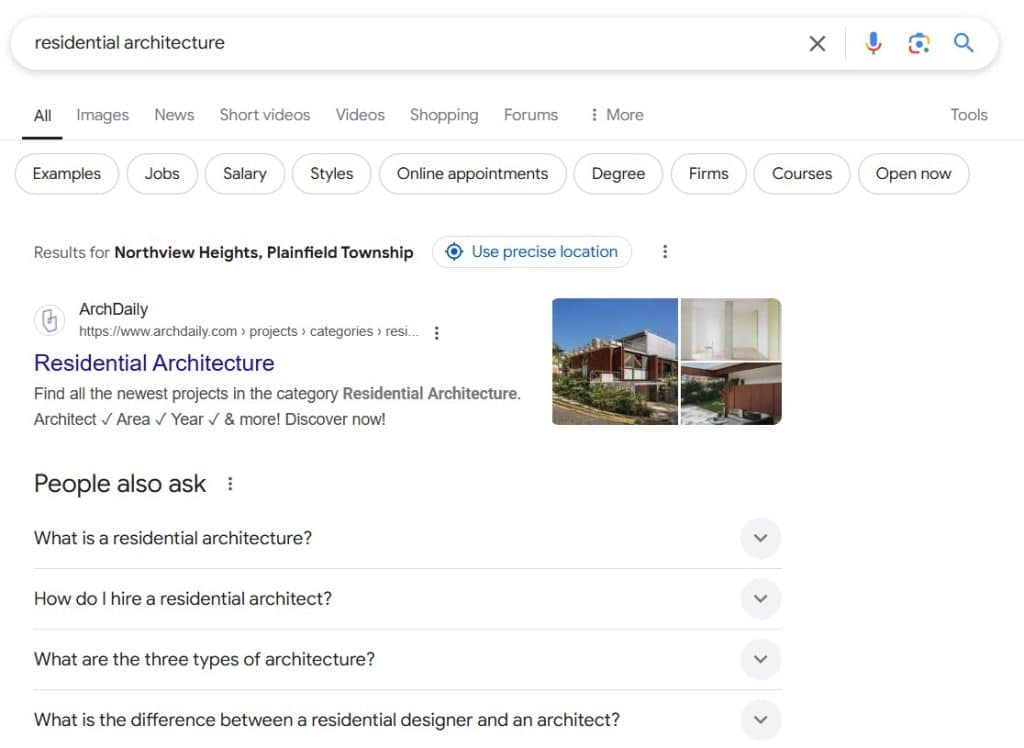
You’ll notice that the top results are informational in nature. Google has assumed someone searching for architecture wants information about architecture projects and examples. Now, if you do a search for architect:

Notice the top results are a 3-pack map result of local businesses. Here, Google assumes the user has commercial or transactional intent and gives the user a direct path to connecting with local architects – one of which is Mathison | Mathison, an old client of ours!
For architectural firms, location-based keywords are also particularly valuable. Include your city, neighborhood, or region in your keyword strategy to capture local searches like “modern architect in Boston” or “commercial architect near me.”
It can be valuable as you do your keyword research to create a worksheet that details your differentiated services along with the locations that you provide them.
| Service | Areas Offered |
| Residential Architect | Chicago |
| Custom Home Design | Evanston |
| Remodel Design | Schaumburg |
| Des Plaines |
This allows you to research all the combinations you can provide, and make unique pages that target each service in each area you serve.
Key tip: There’s a sweet spot for overdoing it and underdoing it as far as creating target pages. Using the keyword table above, it would likely make sense to make 12 unique pages, with each service having a page targeting the area the service is offered. However, we often see websites where architects take this too far by trying to hit every single variation of a service. So, as an example, you might think it would make sense to target both “home architect” and “residential architect” by making a page for each. Fortunately, Google understands that those are the same thing, which is why if you do a localized search in your area for either one you’ll notice the results are virtually identical.
Going in the opposite direction, many architecture firms make a single page that lists multiple services, and this is also a big SEO no-no. As a customer, if you search specifically for something like “remodel architect, des plaines” would you rather land on a page that specifically shows you examples of that service or a page that provides scant details about seven different services? Users, and Google, unsurprisingly, tend to prefer the page focused on remodeling, and you should when you optimize your site.
Get Help From a Professional
Our team can help guide you through the SEO process or manage it entirely. Contact us to learn more.
3. On-Page SEO Strategies for Architects
Once you’ve identified your target keywords, it’s time to optimize your website’s pages to rank for them:
Website Structure and Navigation: Create a logical site structure that makes it easy for visitors (and search engines) to find information. For architects, this might mean organizing pages by service type (residential, commercial, renovation) or project portfolio categories.
Title Tags and Meta Descriptions: Each page should have a unique, keyword-rich title that accurately describes its content. For example, “Award-Winning Residential Architect in Seattle | Firm Name” is more effective than just “Home | Firm Name.”
Header Tags: Use H1, H2, and H3 tags to structure your content logically. Your H1 should contain your primary keyword, while H2s and H3s can target secondary keywords.
Natural Keyword Integration: Incorporate your target keywords throughout your content, but prioritize readability and natural language over keyword density. Search engines penalize content that seems written for algorithms rather than humans.
Image Optimization: As an architect, your portfolio is crucial. In the keyword research section above, we talked about informational versus commercial intent. Images can be a crucial way to reach clients in the research phase as they look for examples. Google regularly includes images in search results when potential clients perform a search such as rustic home architecture:
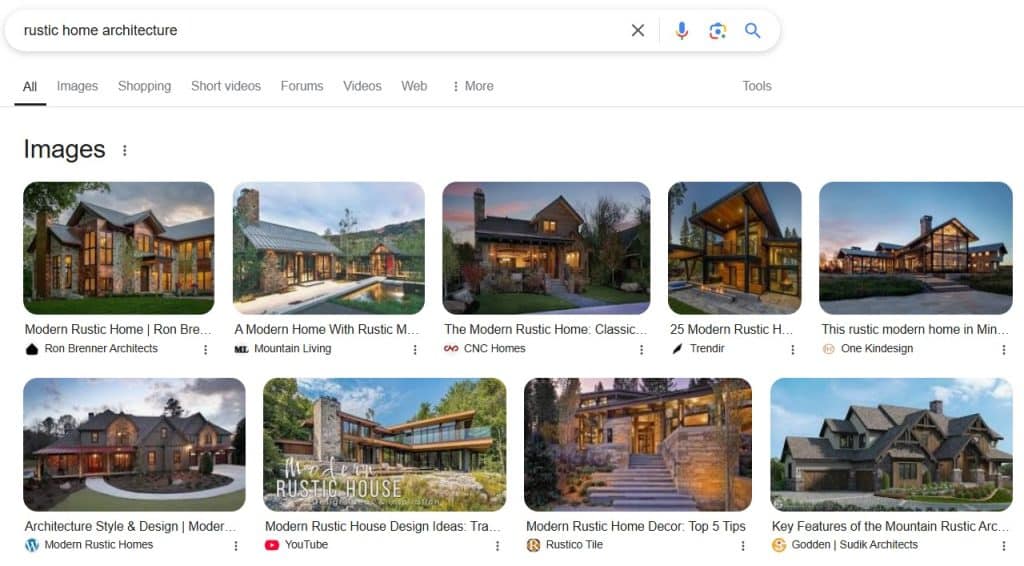
Having your work showcased in these results can offer a national stage to your work and help you generate more leads for your business. Optimize images by:
- Compressing file sizes without sacrificing quality
- Using descriptive file names (e.g., “sustainable-office-design-portland.jpg”)
- Adding alt text that describes the image and includes relevant keywords
Mobile Responsiveness: Ensure your website displays perfectly on all devices. This is particularly important for showcasing architectural work, where visual presentation is key.
4. Creating High-Quality Content for Architectural Websites
Content is where architects can truly shine in their SEO efforts. High-quality, informative content establishes your expertise and gives search engines more material to index.
Develop a content strategy that includes:
Blog Posts: Share insights about architectural trends, sustainable design practices, or the process of working with an architect. Articles like “7 Sustainable Design Elements for Modern Homes” or “How to Budget for Your Commercial Renovation Project” provide value to potential clients while targeting relevant keywords. Try to align your topics to your architectural specialties, and focus on creating content that helps answer users’ questions or informs them about topics related to your key services. As you develop content around a topic these “clusters” can help establish topical relevance that Google will notice. If commercial renovations are your thing, make sure each post on the topic includes a call to action with links directing users back to your commercial renovations service page. These internal links will also be noticed by search engines and provides further evidence of the importance of that page for the topic. Here’s an example:

Case Studies: Create detailed case studies of your projects, explaining challenges, solutions, and outcomes. This content demonstrates your problem-solving abilities and shows real-world applications of your expertise. An underrated component of architecture SEO is user engagement. Google in particular pays attention to how “sticky” your site is. If someone clicks a search result and quickly bounces back out to Google to click on the next result they know your site didn’t meet the user’s needs. Instead, make sure your site offers high-quality, easy to access case studies that engage your users and showcase your designs.
Project Showcases: Feature high-quality photographs of your projects with detailed descriptions that naturally incorporate keywords about the project. Keyword research can help you here as well. Let’s say, for example, that you completed a project for a sustainable building for a commercial client. You’ll want to incorporate the most relevant terms in your page title, heading, and copy.
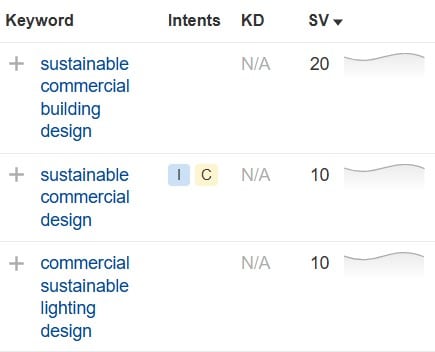
Beyond that, you’ll want to include information about materials, design principles, challenges overcome, and client goals achieved.
Visual Content: Incorporate videos of project walkthroughs, 3D renderings, before-and-after comparisons, and virtual tours. These engage visitors longer and can significantly improve SEO metrics.
Stay Fresh: Search engines favor websites that are regularly updated. Even small content tweaks or new project uploads can help signal that your site is active. Regularly refresh your blog, add new case studies, and update service pages with recent project insights or design trends.
Voice Search and Conversational Keywords: More users are now searching by voice, especially on mobile. Incorporate conversational phrases and questions your ideal client might ask—like “Who’s the best residential architect near me?” or “How much does it cost to build a modern home in Atlanta?” These long-tail, natural phrases help capture voice search traffic.
5. Technical SEO an UX for Architectural Firms
Technical SEO ensures search engines can effectively crawl, index, and render your website:
Crawlability: Create and submit an XML sitemap to search engines and ensure your robots.txt file doesn’t block important content from being indexed.
Structured Data: Implement schema markup to help search engines understand your content better. For architects, this might include Organization, LocalBusiness, and Service schemas.
Site Speed: Optimize loading times by compressing images, minimizing code, and utilizing browser caching. This is especially important for architecture sites with large image files and portfolios.
Duplicate Content: Avoid having multiple URLs showing identical content, as this confuses search engines. Use canonical tags when necessary.
SSL Certificate: Ensure your website has HTTPS enabled, as this is both a ranking factor and builds trust with potential clients.
Add Structured Data (Schema Markup): Structured data, or schema markup, helps search engines better understand your site content. Adding schema for “Architect,” “ProfessionalService,” or “LocalBusiness” can enhance your listings with rich results—like star ratings, office hours, or service categories. This additional context can boost visibility and click-through rates in search results.
Optimize for User Experience (UX): Search engines prioritize websites that are easy to use and navigate. Make sure your site structure is intuitive, with clear navigation menus, mobile-friendly layouts, and fast load times. Consider what a potential client would want to do on your site—view a project, contact you, or explore a service—and make those paths simple and obvious. Good UX improves engagement, which leads to better rankings and more inquiries.
6. Local SEO Strategies to Attract Clients in Your Area
For most architectural firms, local clients represent the bulk of business opportunities. Local SEO helps you appear in searches like the ones you see when you perform a search such as “architects near me” or “best architect in [city name]” that typically lead with a local map pack result like this one:

Local SEO for Architects
Start by claiming and optimizing your Google Business Profile (formerly Google My Business):
- Add complete information about your services
- Upload high-quality photos of your office and projects
- Choose appropriate categories (Architect, Architectural Designer, etc.)
- List accurate business hours and contact information
Actively encourage satisfied clients to leave reviews on Google, which significantly impacts local search rankings. Respond thoughtfully to all reviews, both positive and negative.
Build citations by ensuring your firm’s name, address, and phone number (NAP) appear consistently across business directories, professional associations, and industry websites.
Create location-specific pages on your website for each area you serve, with unique content that addresses the architectural needs and characteristics of that location.
See our full step-by-step guide on optimizing Google Business for Architects
7. Building Backlinks for Architectural Websites
Backlinks—links from other websites to yours—remain one of the most powerful ranking factors. For architects, focus on quality over quantity:
Guest Blogging: Contribute articles to respected architecture or design publications, home improvement websites, or local business blogs. Include a link back to your website in your author bio or within the content when relevant.
Industry Forums and Communities: Participate actively in architecture forums, professional groups, and platforms like Houzz. Provide genuinely helpful advice while subtly establishing your expertise and linking to relevant content on your site.
Business Partnerships: Collaborate with complementary businesses like interior designers, contractors, or real estate developers. Cross-promote each other’s services and link to one another’s websites.
Sponsorships: Local events from little leagues to business organizations are always looking for sponsors. Identify organizations that align with your business’s principles and also offer links back to their sponsors on their websites. These sponsorships can help you build some “link juice” to help you outrank lesser-linked competitors.
Make Linkable Content: If your content is good enough, will link to it, you may just need to do a little work promoting it. This article below showing 20 examples of barndominium designs reeled in links from 48 separate domains!

Avoid shortcuts like buying links or participating in link exchanges, as these can result in penalties. Focus instead on creating content so valuable that others naturally want to link to it.
Don’t Overlook the Power of Internal Linking
Make your content work harder by linking related pages together. If someone’s reading a blog post about sustainable materials, direct them to your green architecture services. This not only improves user flow but also helps search engines understand the relationships between your pages.
8. Utilizing Social Media to Enhance SEO Efforts
While social media doesn’t directly impact search rankings, it plays a crucial role in your overall digital presence:
- Share your blog posts, project updates, and industry news across platforms
- Use platforms like Instagram and Pinterest to showcase your visual work
- Join architecture-focused groups on LinkedIn and Facebook to expand your network
- Engage with followers by responding to comments and messages promptly
Social media drives traffic to your website, increases brand awareness, and helps build relationships that may lead to backlinks—all of which indirectly benefit your SEO.
9. Measuring and Analyzing SEO Performance
To improve your SEO strategy over time, you need to track its performance:
Set up Google Analytics and Google Search Console to monitor key metrics:
- Organic Traffic: The number of visitors coming to your site from search engines
- Bounce Rate: The percentage of visitors who leave without interacting with your site
- Conversion Rates: How many visitors take desired actions, like contacting you or downloading resources
- Keyword Rankings: Your position in search results for target keywords
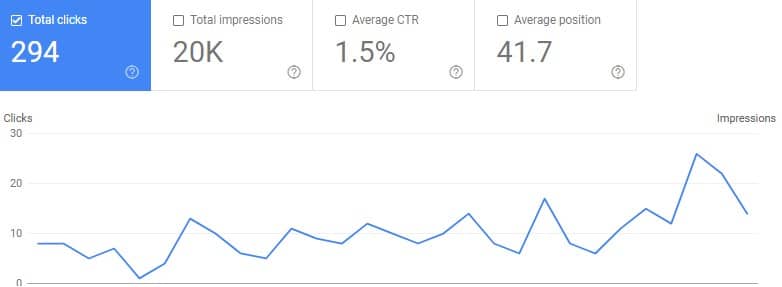
This post started out discussing the importance of goals, and these are the tools and metrics to help you keep tabs on them. Review these key metrics monthly and adjust your strategy accordingly. For example, if a particular blog post drives significant traffic, consider creating similar content. If pages have high bounce rates, improve their user experience or content quality.
10. Future SEO Trends and Their Impact on Architects
Stay ahead of the curve by preparing for these emerging SEO trends:
Voice Search Optimization: As more people use voice assistants, optimize for conversational queries like “Who’s the best sustainable architect near me?”
AI and Machine Learning: Search engines are increasingly using AI to understand user intent. Focus on comprehensive content that answers questions thoroughly rather than just targeting keywords.
User Experience: Google’s Core Web Vitals and other user experience metrics are becoming more important ranking factors. Ensure your site loads quickly, responds well on mobile devices, and provides intuitive navigation.
To future-proof your architectural firm’s SEO, continue educating yourself about digital marketing trends and be willing to adapt your strategy as search algorithms evolve.
11. FAQs: Addressing Common SEO Questions for Architects
How long does it take to see results from SEO efforts?
SEO is a long-term strategy. While some improvements may be visible within weeks, significant results typically take 3-6 months, with continued growth over time.
What is the cost of implementing an SEO strategy?
Costs vary widely based on whether you handle it in-house or hire professionals. Expect to invest anywhere from a few thousand dollars annually for basic SEO to $1,500-$5,000 monthly for comprehensive services from an agency.
Can I do SEO on my own, or should I hire a professional?
Many architects can implement basic SEO strategies themselves, especially content creation and social media management. However, technical SEO and advanced strategies often benefit from professional expertise.
How often should I update my website’s content?
Aim to add new content at least monthly, whether it’s blog posts, project showcases, or case studies. Also review and update existing content regularly to ensure it remains accurate and relevant.
What are the most important SEO metrics to track?
Focus on organic traffic growth, keyword rankings for your target terms, conversion rates, and engagement metrics like time on site and pages per session.
SEO is Critical for Architects
A strategic approach to SEO can dramatically increase your architectural firm’s visibility and client acquisition. By implementing the strategies outlined in this guide—from keyword research and content creation to technical optimization and local SEO—you’ll build a strong online presence that attracts and converts potential clients.
Remember that SEO is a marathon, not a sprint. Consistency, quality, and patience are key to achieving lasting results. Start implementing these strategies today, monitor your progress, and continue refining your approach based on performance data.
The architectural firms that thrive in the digital age will be those that effectively communicate their unique value proposition online and make themselves easily discoverable by their ideal clients. With this guide in hand, you’re well-equipped to be among them.

A very comprehensive to SEO strategies for architects, offering practical insights into on-page optimization, local SEO, backlink strategies, and content creation to help architecture firms stand out in a competitive digital space.